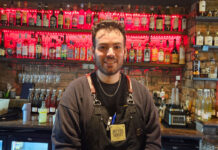Customers want quality and shout about it online when they find it

THE figures don’t lie – premium spirits sales continue to rise as customers visiting the on-trade increasingly seek out quality on the back-bar.
Demand for premium products presents publicans with an opportunity to make some high margin sales, and drinks firms have weighed in with advice on how licensees can cash in on consumer demand for quality.
A spokesman for Halewood Wines & Spirits, the firm behind Liverpool Rum and Whitley Neill gin, said the firm continues to see “a greater demand for premium spirits” as on-trade customers “turn away from the mass market in search of accessible, high-quality alternatives”.
“The category is meeting this demand with products of craftsmanship and rich provenance,” he said.
According to Halewood Wines & Spirits, premium spirits provide customers with “a more memorable experience”, while offering a point of difference for the venue.
“We are definitely seeing a change in the way consumers are viewing spirits and cocktails – by interacting more with bartenders, becoming more educated and sharing ideas,” said the spokesman.
How customers view spirits and cocktails can be a key sales driver. The Halewood spokesman reckons the way a serve looks can have implications for an outlet’s bottom line, with better-looking drinks boosting margins.
“Social media provides great opportunities for outlets to capture snackable content to market to consumers,” he said.
“Consumers drink with their eyes and cocktails are extremely visual so showcasing theatrical, flamboyant and eye-catching drinks garnished with anything from Peychaud’s Bitters to ‘smoke’, will grab attention, create cut through and heighten the experience.”
Pietro Mattioni, managing director at Campari UK, the firm behind brands such as Aperol, Campari, Appleton Estate and Wild Turkey, agreed that the right image can create spirits sales – particularly through social media.
“‘Instagram-worthy’ serves are important as they help consumers to project a desirable, aspirational view of their life through their drink choices – it communicates in one image what the drink ‘says about them’,” said Mattioni.
“The more ‘Instagrammable’ the images are, the more they tell the story of the brand, and the more customers will understand the quality.
“That said, no image can compensate for poor quality among increasingly discerning consumers, so we believe that the proof for customers will always ultimately be in the tasting.”
Quality is at the heart of the growth in premium spirits sales and Mattioni reckons operators would be wise to push the provenance of their range.
“We would advise operators to really communicate the heritage of premium spirits and the distilling/creation process to their customers – to make them seem ‘worth paying more for’,” he said.
“The brands with a rich history and bespoke creation process will capture customer interest and loyalty.”
When it comes to choosing which serves to best show off the quality credentials of a back-bar, Mattioni suggested looking to Latin America and the Caribbean.
“Latin American and Caribbean cocktails are continuing to increase in popularity with Mojitos, Daiquiris and Pina Coladas dominating the share of serves,” said Mattioni.
Premium cocktails were also highlighted as key to driving premium spirits sales by a spokeswoman from Diageo GB.
The spokeswoman said these serves “offer licensees a great opportunity to trade up”, adding that the firm has seen “more consumers than ever opting to drink premium cocktails”.
“A quarter of cocktail drinkers now opt for premium options, with over a third of adult consumers saying they choose them as a treat,” she said.
To take advantage of the heightened demand for premium cocktails, the Diageo spokeswoman suggested operators increase their premium cocktail options, and position them as “the go-to indulgence”.
When it comes to presenting a premium spirit cocktail list, Diageo also encouraged operators to include the brands when listing ingredients.
“Over half of adult consumers think it is important that the brands are listed in the ingredients menu, so outlets need to make it clear when creating their menu,” the spokeswoman said.
Adding more premium spirit-based cocktails is all well and good for a city centre late-night bar, but is there opportunity elsewhere?
The Diageo spokeswoman thinks so, suggesting that the boundaries between styles of outlets have blurred, boosting demand for premium serves across the board.
“Moving into 2017 we will continue to see the boundaries between restaurants and bars blur as restaurant chefs introduce cocktails to their menus and cocktail bars introduce their customers to bar food,” said the spokeswoman.
“What’s more, we strongly believe that spirits present a huge growth opportunity in the casual eating occasion.
“We encourage operators to think about how they maximise this opportunity by inspiring consumers to choose spirits, educating their staff to upsell, and supporting them to achieve consistent quality through the perfect serve.”




















